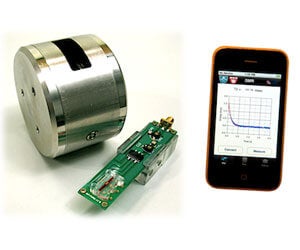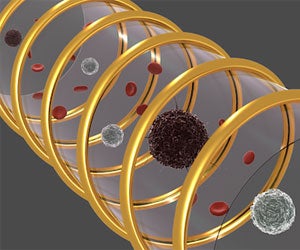A Smartphone Device that Detects Cancer in Under an Hour

Share
If you’re a smartphone naysayer, here’s some news that might make you drink the Kool-Aid along with nearly half of Americans: of the 652 app applications submitted just to Apple every day, an increasing number of healthcare-related apps are starting to trickle in that could actually help save lives. An exciting example comes from the scientists at the Center for Systems Biology at Massachusetts General Hospital that have knocked it out of the park by integrating a microNMR device that accurately detects cancer cells to a smartphone. Though just a prototype, this device enables a clinician to extract small amounts of cells from a mass inside of a patient, analyze the sample on the spot, acquire the results in an hour, and pass the results to other clinicians and into medical records rapidly. How much does the device cost to make? $200. Seriously, smartphones just got their own Samuel L. Jackson-esque wallet.
Considering that more than 1,500 Americans a day will die of cancer according to the American Cancer Society, which translates into almost 1 in 4 deaths, oncologists have needed a rapid, minimally intrusive, and accurate method for cancer screening for a long time. The beauty of the microNMR device is that it solves a handful of problems that plague current cancer screening methods starting with the risks involved in biopsying tissue. If a suspicious lump is found through a mammogram or a colonoscopy, there is no way to be certain if it's malignant or benign without testing the tissue directly. In some cases, the patient has to undergo surgery just to have a sufficient amount of tissue removed for testing. But in other cases, a needle biopsy can be performed, which involves inserting a needle into the mass and extracting a small amount of cells. Some doctors and patients are wary of biopsies because of the risks versus the benefits, especially if a biopsy is being repeated due to an inconclusive result. But one of the main reasons cancer rates in the US have been dropping for years is early detection. In fact, early detection is known to lower mortality rates in breast, colon, rectal, and cervical cancer. Ideally, screening of a suspicious lump should involve the least invasive method possible that would produce accurate results, which would ultimately lower hesitations by doctors or patients to test.
The microNMR device uses very minimal amounts of tissue, approximately 4,000 cells, which is acquired using fine needles that are minimally invasive. Small amounts of cells can be tested because of the various technologies within the microNMR. Back in 2000, the group reported the development of magnetic nanoparticles connected to ligands. When small amounts of the ligands bind to proteins inside of cells, the nanoparticles assemble together and become visible using magnetic resonance imaging (MRI). Building on this work, by 2008, they had developed a miniaturized system the size of a coffee mug that allowed for rapid and accurate measurements. This system utilizes a small magnet and microcoil array to create a miniaturized nuclear magnetic resonance (NMR) device, a technique that has literally transformed chemistry and molecular biology. Samples for testing are delivered to this microNMR chip via another success story in modern science, low-cost easily fabricated microfluidic systems.
By integrating these components together, the microNMR is an awesome device in its own right, but it also solves another screening dilemma: rapid and accurate analysis. Unfortunately, modern biopsy analysis has an 84 percent accuracy rate and can take three to four days to produce results. Furthermore, tissue can degrade during transport to an external testing site and current immunohistochemistry methods can produce false positives. In their latest report, the researchers describe how they addressed these issues by connecting the microNMR to a smartphone for data analysis. This allows a clinician to extract cells from the patient and analyze them immediately rather than sending them away for testing. Through trial and error, the researchers identified four cancer marker proteins that would serve as a screening panel. The result? The system detects cancerous cells from freshly acquired patient samples in an hour with an accuracy of 96 percent in one trial and 100 percent in another across a range of cancer types.
Bridging the microNMR with a smartphone allows the researchers to address the problems of convenient visualization and communication of the results by wisely capitalizing on a technology that many doctors and nurses are already comfortable with. Many medical devices that have their own displays and data handling require training for that particular device. The data output may also be awkward or indecipherable and record keeping may not be convenient. However, as smartphones are intuitive devices and their platforms allow for an easy way to visualize data, training is significantly reduced and data is more accessible. This means that instead of doctors just telling patients, "You have cancer," they can actually review the data with them on the handheld device. The results can also be immediately transmitted to other doctors or into patient records without worrying about compatibility issues.
Together, this device holds an enormous potential for changing the experience of finding out that you have cancer. Imagine your doctor finds a suspicious lump in your body and schedules you for a biopsy. First, you have to undergo surgery to have a sample removed. Then you face anxiety-filled days as the result looms in your mind. Finally, you get the phone call: if it’s negative, you have a huge sigh of relief though you may feel exhausted over the worrisome ordeal. If it’s positive, you now have to schedule an appointment to see your doctor to discuss plans moving forward. Those can be excruciating days of uncertainty as the result hangs like a death sentence for you, family and friends. Now contrast this scenario with one that the microNMR device may someday make possible: a suspicious lump is found, a clinician inserts a small needle into the site on your body, and you sit in the waiting room for about an hour. You're called in and your doctor uses a smartphone to show you all the results of the test. If it’s negative, you walk out of the office and put cancer out of your mind. If it’s positive, you can immediately discuss a game plan and treatment options with your doctor. Emotionally, that is a world of difference.
Be Part of the Future
Sign up to receive top stories about groundbreaking technologies and visionary thinkers from SingularityHub.


The next decade may very well go down as the decade of the smartphone, but it’s comforting to know that it may be due to more than just texting, gaming, and watching YouTube. With an increasing number of healthcare-related apps, smartphones have the potential to bridge the gap between doctors and patients through convenient and rapid access to medical data. We've already highlighted health-related apps that will measure blood-sugar levels and monitor vital signs, but some new apps are aimed at helping doctors by interfacing with medical devices where the smartphone becomes the tool for data handling, visualization, and communication. Devices like the microNMR, the digital stethoscope, and another app that changes a smartphone into a skin cancer screening tool promise to make smartphones revolutionary platforms that improve medicine for both clinicians and patients.
To see a video that features Dr. Ralph Weissleder, the principal investigator for the microNMR, discussing molecular imaging, check out this 2008 video:
[Image source: Center for Systems Biology]
[Sources: American Cancer Society, Center for Systems Biology, Nature, Science Translational Medicine]
David started writing for Singularity Hub in 2011 and served as editor-in-chief of the site from 2014 to 2017 and SU vice president of faculty, content, and curriculum from 2017 to 2019. His interests cover digital education, publishing, and media, but he'll always be a chemist at heart.
Related Articles

New Immune Treatment May Suppress HIV—No Daily Pills Required

Scientists Just Developed a Lasting Vaccine to Prevent Deadly Allergic Reactions

One Dose of This Gene Editor Could Defeat a Host of Genetic Diseases Suffered by Millions
What we’re reading

